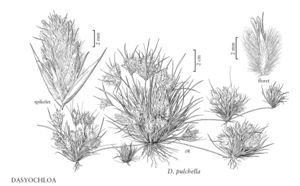| Taxon | Illustrator ⠉ | |
|---|---|---|
 | Dasyochloa pulchella | Cindy Roché Linda A. Vorobik |
Plants perennial; stoloniferous, sometimes mat-forming. Culms (1) 4-15 cm, initially erect, event¬ually bending and rooting at the base of the inflorescence. Leaves not basally aggregated on the primary culms; sheaths with a tuft of hairs to 2 mm at the throat; ligules of hairs; blades involute. Inflorescences terminal, short, dense panicles of spikelike branches, each subtended by leafy bracts and exceeded by the upper leaves; branches with 2-4 subsessile to shortly pedicellate spikelets. Spikelets laterally compressed, with 4-10 florets; disarticulation above the glumes. Glumes subequal to the adjacent lemmas, glabrous, 1-veined, rounded or weakly keeled, shortly awned to mucronate; florets bisexual; lemmas rounded or weakly keeled, densely pilose on the lower 1/2 and on the margins, thinly membranous, 3-veined, 2-lobed, lobes about 1/2 as long as the lemmas and obtuse, midveins extending into awns as long as or longer than the lobes, lateral-veins not excurrent; paleas about as long as the lemmas; anthers 3. Caryopses oval in cross-section, translucent; embryos more than 1/2 as long as the caryopses. x = 8.
Distribution
Md., Colo., N.Mex., Tex., Utah, Calif., Wyo., Ariz., Nev.
Discussion
Dasyochloa is a monotypic genus that is restricted to the United States and Mexico. It has been included in the past in each of the following: Triodia, Tridens, and Erioneuron. Dasyochloa differs from all three of these genera, but resembles Munroa, in its leafy-bracteate inflorescence (Caro 1981). Seedlings of Dasyochloa, like those of Erioneuron, are shaggy-white-villous. This indumentum is composed of myriads of hairlike, water soluble crystals that wash off in water. They are the product of transpiration and evaporation.
Selected References
Lower Taxa
"decumbent" is not a number.